This article will explore the role of tracking and reporting tools in improving the return on investment (ROI) of your influencer marketing campaigns. We’ll explore the different tools available, their benefits, and how they can help you measure and optimize campaign performance.
How to Choose the Best Influencer Marketing Platform and start professionalizing your campaigns.
What are tracking tools?
Tracking tools of theinfluencer marketingare software applications or platforms designed to measure and analyze the effectiveness of influencer marketing campaigns. These tools provide insights and data on various metrics to help brands and marketers evaluate the success and impact of their influencer collaborations.
These tools may include
- Reporting Tools: Collect data on engagement, instagram database campaign earned media rate, and demographics, and compile it all into easy-to-share documents.
- Social listening tools : Monitor social media channels for mentions of your brand, competitor brands, and industry keywords. This can be as simple as setting up Google alerts for a certain keyword or as broad as subscribing to social media management software.
- Campaign Management Workflows: Facilitate influencer search, workflow management, content approval, and communication.
- Monitoring and compliance features: Ensure compliance with advertising regulations and disclosure guidelines.
- Influencer Relationship Management Tools: Manage influencer collaborations, collaboration history, payments, and contracts.
Video in English, but you can put Spanish subtitles
How can performance tracking tools increase your ROI?
So how exactly can tracking tools help you?Maximize your ROI?
Let’s explore some of the biggest benefits of using these tools to improve your campaigns and optimize your investment.
Audience segmentation
Audience targeting capabilities provide audience insights, allowing you to understand the demographics and interests of your influencers’ followers . By aligning influencer partnerships with your this is how much time I invest in my blogs and websites per week target audience, you can improve the relevance and effectiveness of your campaigns , resulting in a higher return on investment.
Campaign Optimization
These features help you optimize your influencer campaigns by providing you with real-time performance data . You can monitor which influencers, content formats, or platforms are driving the most ROI and make adjustments accordingly. For example, if you see that certain influencers aren’t directing their audience to your CTAs, you can address this and ensure they’re providing their followers with the right instructions. These optimization tools help you allocate your budget and resources more effectively for maximum impact.
Profitability
You can use the data that tracking tools provide to calculate the ROI of each influencer you partner with , correlating performance data with associated costs. This helps you identify the influencers who deliver the best results in relation to their fees, ensuring cost efficiency and maximising your ROI.
Data-driven decisions
These tools provide comprehensive data and insights into campaign performance, allowing you to make data-driven decisions. By analyzing metrics such as reach ,engagementand conversion rates , you can identify the most effective content strategies and campaign elements that drive ROI.
Benchmarking
Tracking tools often include features that allow you to conduct tracking tools competitor analysis . By comparing your
influencer campaigns to those of your industry competitors, you can gain valuable insights into their strategies, tactics, and overall performance. This helps you understand industry trends and uncover potential gaps or opportunities . This will help you hone your own influencer marketing strategies, differentiate yourself from your competitors, and maximize your ROI.
Measuring performance at multiple levels
When it comes to measuring performance, it’s also important to facebook users make sure you get a holistic assessment of
the ROI of your marketing efforts. This means looking beyond basic campaign tracking tools metrics to determine not just
how well a campaign is working, but the different metrics that contribute to its success. Can the majority of your
interactions be attributed to an influencer who knows how to elicit a positive response from their audience? Are certain
CTAs not having the desired effect on certain platforms? Tracking tools that measure data at all levels can be helpful in determining these answers.
For example, the Influencity platform includes reporting tools that allow you to compare performance metrics at four key levels:
- Campaign level: Evaluate the overall performance of your campaigns. This includes assessing the collective impact, reach, and engagement generated by your campaigns.
- Social Media Level: Measure the influence of your campaigns across social media platforms. Analyze your performance across social media platforms and use this information to invest in channels that are performing well, make changes to channels that are performing poorly, and identify trends that are winning on each platform .
- Influencer Tier: Evaluate the performance of each influencer collaboration. Assess the impact of each influencer by analyzing metrics such as reach, engagement, and the effectiveness of their content in promoting your brand or products.
- Post Level: Dive into the performance of each individual post created by influencers. Measure metrics like engagement, clicks, shares, and comments to identify which posts connect most with your target audience and contribute to the overall success of the campaign.

